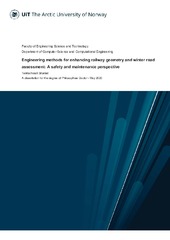| dc.contributor.advisor | Doulgeris, Anthony | |
| dc.contributor.advisor | Hughes, Nick | |
| dc.contributor.advisor | Wagner, Penelope | |
| dc.contributor.author | Pedersen, Joakim Lillehaug | |
| dc.date.accessioned | 2020-01-29T09:00:30Z | |
| dc.date.available | 2020-01-29T09:00:30Z | |
| dc.date.issued | 2019-12-13 | |
| dc.description.abstract | In this thesis,we investigate the potential use of in-situ sea ice observations from
the Ice Watch database as ground truth data for an automated classification
algorithm of sea ice types from Sentinel-1 SAR data. The Ice Watch database and
the Sentinel-1 data archive are searched for in-situ observations and satellite
data acquisitions in Extra Wide swath mode overlapping in both space and
time. Time differences of up to a maximum of 12 hours are accepted and
included in this investigation. The Sentinel-1 data is downloaded in Ground-
Range Detected format at medium resolution and thermal noise correction,
radiometric calibration and additional multilooking with a 3-by-3 window is
applied. Different ice types in the images are then classified with the Gaussian
IA classifier developed at UiT. The resulting image with ice type labels is geolocated
and aligned with the in-situ observation from the Ice Watch database.
A grid of 25-by-25 pixels around the location of the Ice Watch observation
is extracted. For data points with a large time difference between in-situ
observation and satellite data acquisition, a sea ice drift algorithm is applied
to estimate and correct for possible influence of ice drift between the two
acquisition times. Correlation and linear regression is investigated between a
total number of 123 observation and the classified area around the observation.
In addition, per class accuracy for the trained ice types in the classifier is
investigated. A medium to strong positive correlation is found between types of
ice and a weakly negative to no correlation was found for sea ice concentration.
“Second-/Multiyear ice” separation achieves the highest score with 93.8 % per
class accuracy. The second highest scoring class is “Deformed First-Year Ice”,
for which 48.1 % per class accuracy is achieved. The thinner ice performs
poorly due to the low number of representative of observations from these
classes. Based on the findings there is a relationship between the reported
observations from the Ice Watch database and the classified Sentinel-1 images.
The ability to separate the older and deformed ice types from younger level
ice is present. | en_US |
| dc.identifier.uri | https://hdl.handle.net/10037/17253 | |
| dc.language.iso | eng | en_US |
| dc.publisher | UiT Norges arktiske universitet | en_US |
| dc.publisher | UiT The Arctic University of Norway | en_US |
| dc.rights.accessRights | openAccess | en_US |
| dc.rights.holder | Copyright 2019 The Author(s) | |
| dc.rights.uri | https://creativecommons.org/licenses/by-nc-sa/4.0 | en_US |
| dc.rights | Attribution-NonCommercial-ShareAlike 4.0 International (CC BY-NC-SA 4.0) | en_US |
| dc.subject.courseID | FYS-3941 | |
| dc.subject | VDP::Matematikk og Naturvitenskap: 400::Matematikk: 410::Statistikk: 412 | en_US |
| dc.subject | VDP::Mathematics and natural science: 400::Mathematics: 410::Statistics: 412 | en_US |
| dc.subject | VDP::Matematikk og Naturvitenskap: 400::Matematikk: 410::Analyse: 411 | en_US |
| dc.subject | VDP::Mathematics and natural science: 400::Mathematics: 410::Analysis: 411 | en_US |
| dc.subject | VDP::Matematikk og Naturvitenskap: 400::Informasjons- og kommunikasjonsvitenskap: 420::Simulering, visualisering, signalbehandling, bildeanalyse: 429 | en_US |
| dc.subject | VDP::Mathematics and natural science: 400::Information and communication science: 420::Simulation, visualization, signal processing, image processing: 429 | en_US |
| dc.subject | Synthetic Aperture Radar | en_US |
| dc.subject | Sentinel-1 | en_US |
| dc.subject | Machine learning | en_US |
| dc.subject | Gaussian IA-classifier | en_US |
| dc.title | Comparison of the Ice Watch Database and Sea Ice Classification from Sentinel-1 Imagery | en_US |
| dc.type | Master thesis | en_US |
| dc.type | Mastergradsoppgave | en_US |


 English
English norsk
norsk



